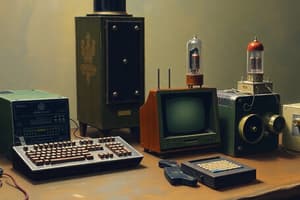Podcast
Questions and Answers
What electronic devices were used in first generation computers?
What electronic devices were used in first generation computers?
- Integrated circuits
- Microprocessors
- Vacuum tubes (correct)
- Transistors
What was the primary improvement of transistors over vacuum tubes?
What was the primary improvement of transistors over vacuum tubes?
- Reduced cost
- Improved reliability and smaller size (correct)
- Enhanced processing speed
- Increased power consumption
What is the primary function of an integrated circuit?
What is the primary function of an integrated circuit?
- To combine multiple transistors and components on a single chip (correct)
- To switch electronic power
- To amplify electronic signals
- To control computer architecture
What is typically used to measure microprocessor speed?
What is typically used to measure microprocessor speed?
What is the primary goal of performance designs in computer systems?
What is the primary goal of performance designs in computer systems?
What is the primary goal of achieving performance balance in a computer system?
What is the primary goal of achieving performance balance in a computer system?
What is the main advantage of multi-core processors?
What is the main advantage of multi-core processors?
Which type of processor is designed for parallel computing tasks and features a large number of processing cores?
Which type of processor is designed for parallel computing tasks and features a large number of processing cores?
What is the purpose of benchmarks in computer performance assessment?
What is the purpose of benchmarks in computer performance assessment?
What is the principle that states that the speedup of a task from parallelization is limited by the portion of the task that must be executed sequentially?
What is the principle that states that the speedup of a task from parallelization is limited by the portion of the task that must be executed sequentially?
Flashcards are hidden until you start studying
Study Notes
First Generation Computers
- Used vacuum tubes as primary electronic components for processing data (1940s-1950s)
- Vacuum tubes were large, fragile, and consumed a lot of power, leading to limitations in computer size, reliability, and performance
Second Generation Computers
- Replaced vacuum tubes with transistors in the late 1950s and 1960s
- Transistors were smaller, more reliable, and more efficient than vacuum tubes, leading to significant improvements in computer technology
Third Generation Computers
- Featured integrated circuits (ICs) in the late 1960s and 1970s
- ICs combined multiple transistors and other electronic components on a single semiconductor chip, further reducing size, cost, and power consumption while increasing performance
Performance Designs
- Methodologies and techniques used to optimize the performance of computer systems
- Includes microprocessor design, architecture, and balance between different components
Performance Metrics
- Microprocessor speed: measured in megahertz (MHz) or gigahertz (GHz)
- Higher clock speeds generally result in faster processing performance
- Performance balance: achieving an optimal allocation of resources within a computer system to maximize overall performance
Microprocessor Architecture
- Refers to the arrangement and design of components within a microprocessor or integrated circuit
- Includes the layout of transistors, interconnections, and functional units
Multi-Core and Parallel Processing
- Multi-core microprocessors have multiple processing cores on a single chip, allowing for parallel execution of tasks
- MICs (Many Integrated Cores) are specialized processors for parallel computing tasks
- GPGPUs (General-Purpose Graphics Processing Units) are graphics processing units repurposed for general computing tasks
Performance Assessment
- Evaluating the speed, efficiency, and overall performance of computer systems using various metrics, tests, and benchmarks
- Clock speed and instructions per second are used to measure processor performance
- Benchmarks are standardized tests used to compare the performance of computer hardware and software components
Laws and Formulas
- Amdahl’s Law: the speedup of a task from parallelization is limited by the portion of the task that must be executed sequentially
- Little’s Law: relates the average number of customers in a system to the average time spent by a customer in the system and the average rate at which customers enter the system
Studying That Suits You
Use AI to generate personalized quizzes and flashcards to suit your learning preferences.




